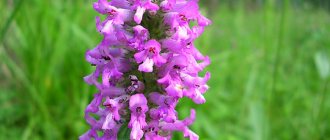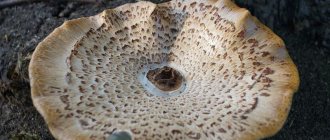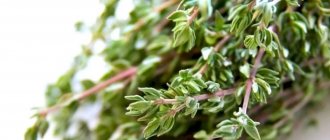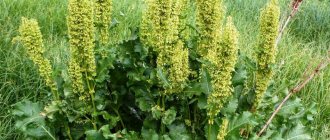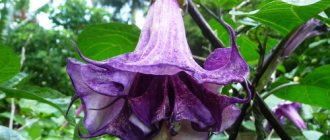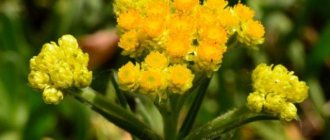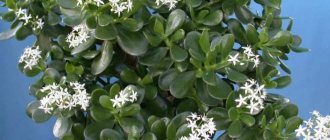What does Veronica officinalis look like and where does it grow?
Veronica officinalis belongs to the Plantain family. It is a herbaceous perennial plant
You can find the grass throughout almost all of Europe, Turkey, and Iran. In Russia, it grows in the European part; its range also includes the northern regions. Veronica officinalis is also found in the Azores and Madeira archipelago.
The main habitats include meadows, forest glades, forest edges, mountains up to the subalpine zone. The plant is found among bushes. It prefers unshaded places.
Veronica officinalis grows up to 15-30 cm in height, occasionally specimens up to 50 cm long are found. Its stem is round, creeping, and branched. It is evenly pubescent. Ascending branches extend from it. The creeping stem can take root at the nodes.
The leaves of medicinal speedwell are rough, opposite, elliptical or obovate in shape. They can be from 1.5 to 4 cm in length, 1.5-2 cm in width. Towards the base, the leaves narrow and turn into a hard, short stalk. Their edges are jagged or jagged. The top of the leaves can be either pointed or blunt. The surface is covered with hairs on both sides. The leaves are green in color.
The rhizome of Veronica officinalis is creeping, sinuous, and the roots are small.
The plant blooms from late May to early October. A thick peduncle emerges from the axils of the upper leaves. It is completely covered with light hairs. The color of speedwell flowers varies from lavender to blue with dark veins. But there are white and soft pink flowers. They are collected in loose multi-flowered racemes.
In moist places, Veronica officinalis forms thickets, covering areas with a continuous carpet
Veronica Dubravnaya photo and description
Veronica oak grove Veronica chamaedrys L. is a perennial herbaceous plant 10–40 cm high with a creeping rhizome and ascending or erect stems. Bright blue flowers are collected in opposite clusters of few flowers in the axils of the upper pair of leaves. Blooms from late May to August.
Grows on forest edges, glades, steppe slopes. The plant has adapted to the lack of moisture; it waters itself, using all the moisture that falls on it. Its leaves are opposite, the hairs on the stem are arranged so that when water hits the leaf, it runs down the hairs towards the root.
If under other plants it is sometimes dry even after a heavy downpour, then under Veronica oak grove it is always wet and humid even after any light rain.
The species name chamaedrys comes from the Greek words chamai - low and drys - oak, named after the main places where the plant grows.
Chemical composition of Veronica officinalis
The beneficial properties of the herb are due to its composition. Medicinal veronica contains:
- carbohydrates;
- organic acids;
- essential oils;
- iridoids;
- sterols;
- saponins;
- phenolcarboxylic acids and their derivatives;
- flavonoids;
- ascorbic acid;
- tannins;
- coumarins;
- choline
Trace doses of cardiac glycosides and alkaloids were detected in the composition. Beneficial substances are found in all parts of the plant.
Comment! Veronica officinalis is one of the little-studied plants. But scientists managed to find out how it affects humans.
Compound
Veronica officinalis is a short herb with soft lilac (less often bluish or white) flowers collected on the upper part of the stem in small multi-flowered clusters. The stem reaches a height of no more than 30 cm, all covered with small soft fibers. The leaves are also soft and woolly, the roots are shallow and branched. Until you see the herb Veronica officinalis in the photo and read the description, you can’t even believe that it has such a wealth of medicinal properties.
Veronica officinalis grows on the edges, in forests, in meadows, and blooms in the second half of summer. It is found throughout Ukraine, Belarus, the European part of Russia, Turkey and Iran. It is believed that the name of the herb comes from the Greek name Ferenike, which means “one that brings victory.” Other names for the plant are oak grass, snake grass, okladnik.
The chemical composition of Veronica officinalis has not yet been fully studied. But according to the results of the studies, the plant contains:
- cardiac glycosides;
- iridoids (bitterness);
- hydroquinone;
- essential oils;
- organic acids: citric, acetic, tartaric, lactic;
- phenolcarboxylic acids;
- tanning components;
- vitamin C;
- carbohydrates and related compounds;
- nitrogen-containing compounds choline;
- steroid derivatives.
The herb is healing only during flowering; the above-ground part is used in treatment: stems, leaves and flowers.
Medicinal properties of Veronica officinalis
Substances contained in medicinal speedwell have the following types of effects when they enter the body:
- anti-inflammatory;
- antimicrobial;
- antitoxic;
- antitussive;
- bronchodilator;
- analgesic;
- hemostatic;
- fungicidal;
- hepatoprotective;
- antitussive.
This is not a complete list of the beneficial properties of Veronica officinalis. It has anticonvulsant and anthelmintic effects. For problems with the digestive system, the herb is used as an astringent, helps reduce acidity, and improve the absorption of nutrients.
The plant also affects carbohydrate metabolism. When infusions and decoctions of this herb are included in the diet, metabolism improves, appetite increases, and the secretion of gastric juice is stimulated.
Infusions and decoctions from the plant are used for treatment:
- respiratory tract diseases, incl. chronic;
- dermatitis;
- headache;
- gastritis;
- initial stage of ulcerative lesions of the gastrointestinal tract;
- rheumatism;
- fungal skin infections.
We recommend reading: Sacred Boswellia: benefits and harms of extract, oils, side effects
They recommend medicinal veronica for problems with the liver, kidneys, and gall bladder. As an external remedy, it is used to treat boils, burns, and festering wounds.
The herb has a positive effect on the nervous system. It is recommended for patients with anxiety disorders, insomnia, problems with memory and concentration.
The use of Veronica officinalis herb in folk medicine
Fans of alternative methods of treatment use medicinal herbs in the form of water and alcohol infusions, decoctions, juice, and powder. In Russia, official medicine does not use Veronica officinalis, but in Western European countries you can find products made on its basis.
For the preparation of infusions, oils, decoctions, and powders, pre-dried speedwell is used.
Infusions
To prepare the infusion, you need to take 1 tbsp. l. dried Veronica officinalis, the plant is filled with 200 ml of cold water. The liquid should be brought to a boil and allowed to brew for 30 minutes in a thermos or pan, covered with a towel.
The use of the product is recommended for patients who:
- indigestion caused by disruption of the small intestine;
- gastritis with high acidity;
- dry, persistent cough;
- headaches caused by nervous tension;
- gout;
- rheumatism;
- neurological disorders;
- prolonged insomnia;
- anorexia.
Women are advised to take the infusion to eliminate premenstrual syndrome and menopausal disorders. It has a positive effect on the condition of inflammatory diseases of the genitourinary system.
Important! Most often, Veronica officinalis is recommended for respiratory diseases. The herb has antispasmodic, mucolytic and anti-inflammatory effects.
The prepared infusion should be drunk 100-120 ml three times a day.
Tinctures
For external use, traditional healers advise using an alcohol tincture of Veronica officinalis; to prepare it, the herb is first crushed. For 1 glass of fresh raw materials, the same amount of alcohol will be required. The tincture is prepared for 10 days in a dark place. After the specified period has passed, the liquid is filtered. Before use, add the same amount of alcohol and filter.
A tincture of Veronica officinalis is used to treat the skin for dermatological diseases. It should be shaken before use.
You can also prepare a juice-based tincture. To do this, 100 ml of squeezed juice is mixed with the same volume of alcohol. The liquid should be infused for 10 days. After the specified period has passed, it should be filtered through cotton wool. After this, you need to add another 100 ml of alcohol and strain again. It is advisable to pour 10 ml of Peruvian balsam into the prepared mixture.
Use the tincture to treat the skin, including the scalp. It is recommended for cuts, bruises, itching, and minor wounds. It is used in the form of rinses and compresses. The product is pre-diluted with water in a ratio of 1:2.
Decoctions
For diseases of the respiratory tract and gastrointestinal tract, you can use a decoction of Veronica officinalis. To prepare it, 1 tbsp. l. dry herbs are poured with a glass of boiling water and boiled for 15 minutes.
The decoction should be taken 1 tbsp. l. three times a day. It is also added to baths. It has a positive effect on the skin of patients with diathesis, fungal infections, eczema, rashes, and purulent ulcers.
Dried and crushed herb of medicinal veronica is used to prepare decoctions; the liquid must be strained before use.
Oil
From Veronica officinalis you can make not only infusions and decoctions, but also oil. To prepare it, add 50 ml of olive oil to 50 g of herb. The product should be infused for at least 2 weeks in a warm place. It needs to be shaken periodically. The strained oil should be used to treat the skin.
Attention! The product is recommended for sunburn. The affected areas should be lubricated with oil extract.
Powder
If the dried herb is crushed, it can be made into a powder. It is used as a remedy for diaper rash. The powder is used for excessive sweating of the feet. To do this, pour it into socks and wear them at night. A course lasting 10 days is enough to get rid of the problem.
We recommend reading: Burdock juice: what it treats, what it helps with, benefits and harms, reviews
Indications for use
Before using any prescription, you must obtain the approval of your physician. Most often, Veronica is taken for the following conditions:
- stomach diseases (low acidity);
- respiratory tract diseases;
- digestive tract disorders (eg, diarrhea);
- diseases of the genitourinary system;
- chronic fatigue syndrome;
- migraine;
- skin diseases;
- diseases of the nervous system;
- gout;
- menopause
for the preparation of medicinal products, you can use pharmaceutical raw materials or prepared independently
Traditional medicine recipes
Veronica is used in the following recipes:
- Tea. 0.5-1 tsp. The plants must be filled with 1 cup of boiling water. The tea is drunk warm, adding a spoonful of honey. The drink is taken for skin and kidney diseases, scrofula, rheumatism. Tea is used when coughing to thin sputum. It is not recommended to drink more than 1-2 cups of product per day.
- Goat milk infusion. To prepare the medicine, use freshly squeezed veronica juice, 3-4 tbsp. l. which is mixed with 200 g of heated goat milk (it is not recommended to replace it with the milk of other animals, for example, cows). The medicine must be infused for at least 1.5-2 hours. The drink is taken 4-5 tsp. during the day. The milk should not have time to sour. The drug is most often used in the treatment of inflammatory processes in the kidneys.
- Ointment. To prepare the product, mix 100 g of fresh chopped grass with 100-200 g of any animal fat. It is undesirable to use industrially produced creams, since finished cosmetics contain other active ingredients. They will interfere with the action of Veronica. The product is applied to the skin and left for 20-30 minutes, then washed off with warm water. The ointment is used to treat skin diseases.
- Tincture. 100 freshly squeezed herb juice is mixed with 200 g of vodka. The medicine must be infused for 10-15 days. The tincture is used to treat fungal diseases of the scalp.
- Bath. Application is recommended not only for skin diseases. The procedure alleviates the patient's condition during ARVI. To prepare a solution, pour 1 liter of boiling water into a mixture of 2-3 tbsp. l. Veronica and 2-3 tbsp. l. calendula. The broth is infused for 10-15 minutes, and then it is diluted with 2-3 liters of warm water. The procedure lasts 15-20 minutes.
Products for external use from the herb Veronica officinalis should be used in courses of 20-30 days. Medicines for oral use are taken in courses of 10-15 days. If after the first dose the patient’s well-being worsens, the drug should be abandoned.
the plant is used for cosmetic purposes, as well as in veterinary medicine and everyday life
The use of Veronica officinalis in cosmetology
The plant is used not only in medicine, but also in cosmetology. Thanks to its astringent and antifungal properties, the herb helps get rid of dandruff. For medicinal purposes, alcohol tincture is used. It is rubbed into the skin after each shampoo until the dandruff disappears.
But this is not the only benefit of Veronica officinalis. Cosmetologists advise people with oily skin to use the herb. You can improve its condition if you wash your face with the prepared infusion twice a day.
To get rid of pimples and acne, it is recommended to make a mask from the following components:
- 2 tbsp. l. Veronica officinalis decoction;
- 1 tsp. honey;
- crushed oatmeal.
The mixture should be viscous and creamy. The mask is applied to the face for 10 minutes.
Folk recipes
Infusion for the treatment of furunculosis
Mix Veronica herb in equal proportions with St. John's wort, cornflower, stinging nettle, yarrow, marigold, horsetail, tricolor violet and string. The components must be dried and crushed. Brew the raw material, literally 30 grams of boiled water - a liter. Infuse the mixture in a thermos overnight. Drink 150 ml of the drink at least six times throughout the day. The duration of the course is one and a half months.
Eczema, scrofula: treatment with a healing drink
Steam three tablespoons of crushed flowers and leaves of the plant with 500 milliliters of boiling water. Leave the product to sit. Drink 100 ml of the drink instead of tea four times a day.
Skin pathologies: infusion therapy
Combine equal amounts of speedwell with cornflower, calendula flowers, walnut leaves, and horsetail herb. Grind the ingredients and mix thoroughly. Brew about forty grams of raw material with boiled water - half a liter. Let the composition brew. Drink 100 ml of the drink five times a day.
Arthritis, gout, articular rheumatism: treatment with a collection
Mix fifteen grams of veronica with tricolor violet, large burdock, wheatgrass rhizome - with the same amount. Brew two tablespoons of the mixture with half a liter of boiling water. Let the product sit for a while. Drink a quarter glass of the medicine at least four times a day.
Veronica officinalis for the treatment of gastrointestinal pathologies
Mix fifteen grams of speedwell with prickly tartar, cinnamon rose hips, white birch, Elecampane, dandelion rhizomes, wild strawberry leaves, medicinal hyssop, peppermint, elecampane rhizomes - ten grams of each plant. Thirty grams of the mixture must be steamed with boiled water - 400 milliliters. The composition should infuse overnight. It is recommended to drink half a glass of the drink four times a day.
Insomnia: treatment with infusion
Combine equal proportions of veronica leaves with fragrant violet, lavender flowers, lemon balm, and barberry. Steam fifteen grams of the mixture with just boiled water. You need to leave the mixture until it cools down. Take ½ glass four times a day.
Prostate adenoma: the use of a healing drink
Mix ten grams of speedwell grass with golden rod grass, hawthorn, horehound, sweet clover, bedstraw, sparrow grass, steelweed and cinquefoil rhizomes - eight grams of each plant. Brew thirty grams of the mixture with boiling water - 300 ml. Let the composition brew. Drink 150 ml of the product twice throughout the day: in the morning and in the evening.
Treatment of stomach cancer
Steam ten grams of dry veronica herb with boiling water - 500 ml. Leave the mixture to sit for several hours. Drink ½ cup of the drug three times a day.
Contraindications
Despite all the medicinal properties of veronica, it is prohibited to use the herb if there are contraindications. It is not recommended to take products prepared based on the plant:
- children under 3 years old;
- hypotensive patients;
- patients with severe heart disease;
- people with individual intolerance.
Herbs can be used during pregnancy and lactation only on the recommendation of a doctor. Self-treatment with traditional methods is prohibited during these periods.
If you are allergic to various medicinal plants or foods, use infusions and decoctions with caution. If any undesirable reactions occur, their use should be discontinued immediately.
Helpful information
Herbalists recommend:
- For kidney disease, it is recommended to take 3 teaspoons of fresh plant juice 30 minutes before meals. You can get freshly squeezed juice only during flowering.
- During the rest of the year, it is recommended to take an alcohol tincture: mix the plant juice and vodka in a 1:2 ratio and leave for 10 days. Take diluted orally or pure externally.
- For neurodermatitis and eczema, herbalists prepare an ointment: chop 1 part of fresh herb and mix with 4 parts of fresh lard (melted lard). Store the ointment in the refrigerator and use it to lubricate rashes or skin inflammations.
Application in other areas:
- an unpretentious plant with beautiful flowers is often planted in flower beds or front gardens;
- young leaves are used as a seasoning for marinating meat dishes;
- fresh flowers are used to flavor homemade tinctures.
Veronica officinalis is a good honey plant, but honey does not have medicinal properties. But camel thorn
- a real home pharmacy.
Collection and preparation of grass
You can collect medicinal veronica throughout the flowering period, but it is best to do this in June. During this period, the inflorescences are already formed, but there are no dry leaves yet. The optimal period for collecting raw materials is considered to be the morning. It is better to choose a time when the dew has already disappeared, the outside temperature is 16-20 ° C, and the humidity is 60-80%.
Herbalists recommend harvesting all above-ground parts of the plant without separating them into components.
The collected raw materials should be dried in a shaded, cool place. The plant should not be exposed to direct sunlight.
Important! If the leaves have turned black, they cannot be used. They should turn pale green.
In special dryers, the raw materials are kept for several hours at a temperature of 35-40 °C. Readiness is indicated by the appearance of a pleasant smell that is not characteristic of fresh grass. When drying out, the plant loses about 80% of its mass.
Properly dried speedwell can be stored for 2 years. It is better to keep it in linen bags or glass containers.
Description of the plant and collection
The herb is used to treat chronic and acute diseases associated with the respiratory system and digestive tract. However, the range of its use is wide - Veronica can even relieve pain in the temporal lobe, relieve pain in the joints, and also reduce the manifestations of allergy symptoms on the skin.
The plant grows mainly in hilly and mountainous areas. Medicinal speedwell has leaves of a memorable shape - they reach a length of 15 centimeters and have an oblong shape.
They gradually taper towards the base. The flower itself is not bright - it has a rather pale color.
The inflorescences are purple, blue and white. Each flower is divided into four parts and has a corolla with four petals. The inflorescence is collected in a raceme consisting of leaves at the top of the stem .
There are several rules that must be followed during collection. First of all, you need to pay attention to the cut - it should not go right to the root.
At the moment of flowering, the grass is collected as carefully as possible, without damaging the flowers and leaves.
After collection, it is dried outdoors in the shade or in the oven at the lowest temperature.
It is important that during drying the inflorescences do not change color or fall off.
Properly dried raw materials have a pleasant aroma, slight bitterness and astringency in taste. The weed must be stored dry for 24 months .
